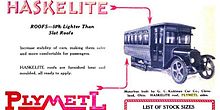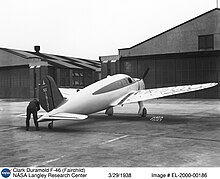Haskelite

Haskelite is the brand name of a plywood, once made by the Michigan-based Haskelite Manufacturing Corporation. It was made from waterproof glue developed by Henry L. Haskell. The moldable plywood was originally called Ser-O-Ply. It was used in the construction of various vehicles including military tanks, boats, airplanes, buses, trucks, and automobiles. The plywood was manufactured with different characteristics depending on particular needs and then given a brand name.
Background
Haskell invented a process for making a waterproof glue called "black albumin glue"[1] from blood-albumin which was used to bond wood[2][3] including a lightweight waterproof plywood which was initially known as Ser-O-Ply. The plywood was used for boats, airplanes, tanks, trucks, automobiles and rail cars.[4] The plywood panels had various layers of crossed-grain ply veneers to create the thickness and strength. Typical moldable plywood panels were about 5 feet (1.5 m) wide by 20 feet (6.1 m) long and 3⁄16 inch (4.8 mm) thick.[5] The sheets made this way were eventually given the brand trade name of "Haskelite" after the inventor.[6][7]
Haskell formed a company for making plywood that ultimately became the Haskell Manufacturing Company in Ludington, Michigan, and the Haskelite Manufacturing Corporation in Grand Rapids, Michigan. The glue was applied cold and spread onto wood veneers with rollers. A stack of three sheets of veneer was then put through a press, where each panel was subjected to a pressure of 150 pounds per square inch (1.0 MPa) between metal plates at 210 °F (99 °C).[6] This pressure and heat made the bond between the veneers permanent and the glue became insoluble.[3] The plywood was given brand names depending on its characteristics.[8] Plymetl had metal faces and was used in construction of airtight clothes vaults for storing furs and expensive garments.[9] Plymold was a plastic-based plywood that could be molded, and Phemaloid was a fire-resistant paneling.[10]
Airplanes

Haskelite was used for aircraft parts, especially fuselages and wings[3] starting with the Curtiss two-place fighter Whistling Bill which was the first molded plywood based aircraft.[11] Haskell plywood was also used for construction of experimental and commercial aircraft[12] including a 1927 Johnson Twin-60 experimental airplane with 85% Haskelite plywood in its wings, seats, instrument board, and fuselage parts.[13] The first successful commercial airplane it was used on was the 1937 Fairchild Aircraft F-46.[14]
During World War I the company produced over 5,000,000 square feet (460,000 m2) of plywood for use in aircraft.[15][16][17] In 1927, the company manufactured aircraft body parts for Charles Lindbergh's Spirit of St. Louis single engine plane, and during World War II Haskelite was used for parts for airplane trainers, gliders, bombers, and transports including components for Britain's De Havilland Mosquito fighter bombers and the Cessna AT-17 Bobcat.[17]
Duramold
In 1939 a waterproof plywood called Duramold, consisting of thin veneers of wood and cloth joined together using glue, heat and pressure, and designed for aircraft construction was invented. Duramold weighed about one-third of the weight of the aluminum alloys used at the time whilst being stronger and an entire fuselage could be turned out in two halves then sealed together mechanically.[18]
The General Bakelite Company and Haskelite Manufacturing joined the Clark Aircraft Company of Hagerstown, Maryland to manufacture planes designed by Virginius E. Clark using Duramold[19] with additional financing provided by Howard Hughes.[20]
Boats and canoes
Haskelite was also used to make watercraft,[21] including the Haskell canoe, which was made from a single sheet of birch and redwood plywood molded into the shape of a canoe using hydraulic presses and fastened at the bow and stern with a bent strip of ash.[3][4][7]

The canoes were first made in 1916, put on the market for sale in 1917 and in 1930 lengthened to 17 foot (5.2 m) instead of the original 16 foot (4.9 m).[4] The Haskell canoe was marketed, sold and used throughout the United States and Canada.[22]
See also
References
- ^ "Manufacturers: Haskell Boat Company". W C H A. Wooden Canoe Heritage Association. 2016. Retrieved May 12, 2016.
- ^ Veneers and Plywood 1930, p. 18.
- ^ a b c d Dunbar 1955, p. 439.
- ^ a b c Veneers and Plywood 1930, p. 19.
- ^ Williams, Leonard P. (December 22, 1952). "Into Plywood Business". The Ludington Daily News. Ludington, Michigan. p. 7 – via Newspapers.com
 .
.
- ^ a b Vehicle Monthly 1919, p. 54.
- ^ a b Motor Boat 1920, p. 38.
- ^ Hardwood Record 1920, p. 30.
- ^ "Plymetl 'Air-Tite' clothes vault". Chicago Tribune (advertisement). November 9, 1923. p. 16 – via Newspapers.com
 .
.
- ^ Marine Engineering 1933.
- ^ Kane 1976, p. 70.
- ^ "Haskelite, Hughes to Build Planes". The Ludington Daily News. August 1, 1939. p. 1 – via Newspapers.com
 .
.
- ^ "New Johnson Twin 60 adopts Haskelite". Aero-Digest. 10: 2. 1927. Retrieved May 12, 2016.
- ^ "Ludington is Birthplace of Plywood Airplanes". The Ludington Daily News. July 15, 1943. p. 3 – via Newspapers.com
 .
.
- ^ Cabot, James L. (June 26, 1993). "Local Company Contributed to war effort". The Ludington Daily News. p. 4.
- ^ "Carrom Company Is Diversified". The Ludington Daily News. September 3, 1965. p. 13 – via Newspapers.com
 .
.
- ^ a b Beld 2012, p. 99.
- ^ "New Process Developed by Chicago Firm". Chicago Tribune. January 22, 1939. p. 25 – via Newspapers.com
 .
.
- ^ New York Herald Tribune (July 9, 1939). "Speedy Production of Planes is Seen". The Miami News. p. 9 – via Newspapers.com
 .
.
- ^ "Plastic Airplane Industry is near". Lansing State Journal. Lansing, Michigan. August 10, 1939. p. 3 – via Newspapers.com
 .
.
- ^ "New Material Used in Boats". The News-Palladium. Benton Harbor, Michigan. June 24, 1939. pp. 1, 3 – via Newspapers.com
 .
.
- ^ "For Haskell Canoe: Boats from Local Factory Used by Bear Hunters; Said to be Safest". The Ludington Daily News. June 30, 1930. p. 3 – via Newspapers.com
 .
.
Sources
- Beld, Gordon G. (2012). The Early Days of Aviation in Grand Rapids. Charleston, South Carolina: Arcadia Publishing. ISBN 978-1-61423-805-8. OCLC 945368042.
- Dunbar, Willis Frederick (1955). Michigan Through the Centuries. Detroit, Michigan: Lewis Historical Publishing Company.
- "Veneer Enters Vast New Field". Hardwood Record. Vol. 49. April 25, 1920. pp. 29+.
- Kane, Joseph Nathan (1976). Famous First Facts and Records. New York City: The H. W. Wilson Company. p. 70.
The first airplane of molded plywood was the "Whistling Bill," a two-place fighter, built in 1918 by the Curtiss Aeroplane and Motor Company, Garden City, Long Island, N.Y. The fuselage was made of four 3/32nd-inch longitudinal sheets of Haskelite, three-ply birch plywood, steamed and formed to contour in a concrete die.
- "Marine Engineering and Shipping Age". Vol. 38. June 1933. pp. 208–13.
{{cite magazine}}: Cite magazine requires|magazine=(help) - "Haskelite, a Plywood for Boat Construction". Motor Boat. Vol. 17. November 10, 1920. p. 38.
- "Why Haskelite flat panels are once and for all flat". The Vehicle Monthly (advertisement). Vol. 55. July 1919. pp. 54–55.
- "Veneers and Plywood". Vol. 24. S.H. Smith. 1930. p. 19.
{{cite magazine}}: Cite magazine requires|magazine=(help)
External links
 Media related to Haskelite at Wikimedia Commons
Media related to Haskelite at Wikimedia Commons Media related to Haskell canoe at Wikimedia Commons
Media related to Haskell canoe at Wikimedia Commons
